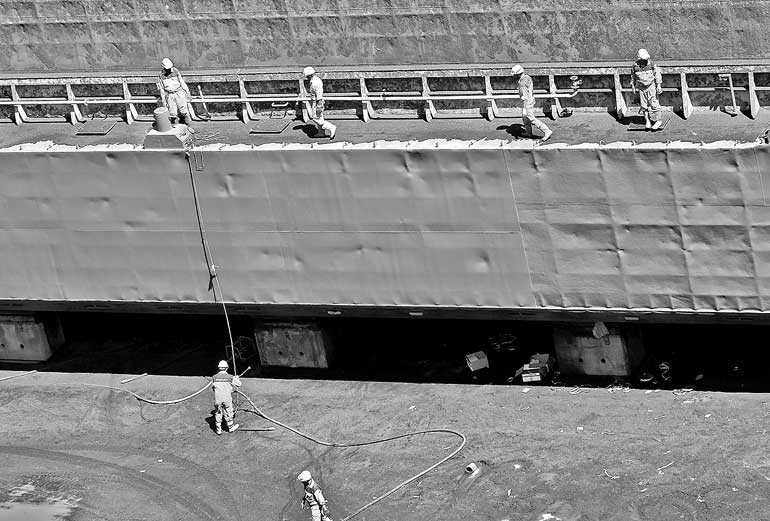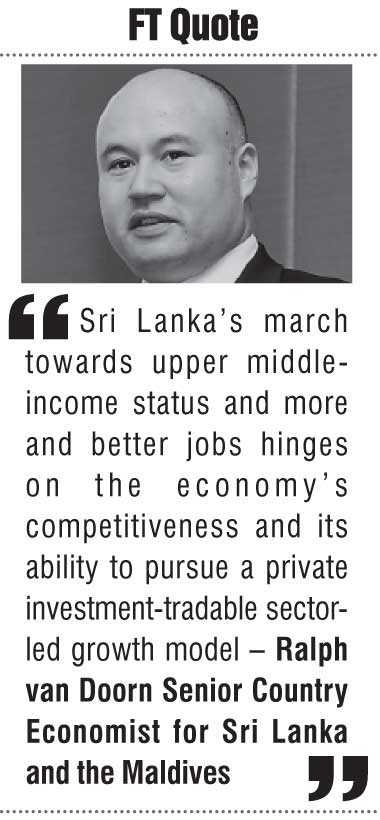Saturday Feb 22, 2025
Saturday Feb 22, 2025
Saturday, 30 June 2018 03:48 - - {{hitsCtrl.values.hits}}

In 2017, for the first time in decades, Sri Lanka’s fiscal revenue exceeded expenditures excluding interest payments, leading to a primary fiscal surplus. However, despite this and other improvements in macroeconomic performance, the island nation remains vulnerable.
Natural disasters continue to take their toll on the GDP, while the pace of urgent fiscal reforms has lagged in a challenging political environment, says the World Bank Sri Lanka’s new Development Update (SLDU).
Released twice a year, the report analyses the country’s performance over the last six months and highlights crucial developments against the global context.
The latest edition of the SLDU notes that economic growth slowed down to a 16-year low in 2017 due mainly to adverse weather conditions. This had a knock-on effect, as inflationary pressures remained high due to drought, VAT changes, and demand pressures. The external trade balance weakened, and agriculture and related sectors were hit hard by successive floods and droughts, resulting in growth decelerating to 3.3%.
On the balance, official reserves hit a record high in April 2018 thanks to capital inflows. Growth is expected to rebound in 2018 from a low base and continue to be around 4.2% in the medium term, driven by private consumption and investment. The VAT reforms were among several measures that led to improved revenue collection. Implementation of the Inland Revenue Act — which came into effect in April 2018 — is expected to structurally increase tax revenue.
“Sri Lanka’s march towards Upper middle-income status and more and better jobs hinges on the economy’s competitiveness and its ability to pursue a private investment-tradable sector-led growth model,” says Ralph Van Doorn, the World Bank’s Senior Economist for Sri Lanka and the Maldives.
Highlighting the challenges posed by domestic political considerations and institutional constraints on implementing policies, Van Doorn added, “A strong political will and support of the bureaucracy could help advance the reform agenda.”
To transition into Upper middle-income status, Sri Lanka will have to embrace a new growth model and improve its economy’s competitiveness.
With that in mind, the Government has begun to implement the extensive and ambitious reforms outlined in Vision 2025, notably phasing out of para-tariffs, simplifying and speeding up procedures for investment, trade and setting up a business.
Aimed at enhancing competitiveness, improving governance and streamlining public financial management, the reforms are expected to bring in long-term benefits.
However, a challenging domestic political environment has already taken a toll, slowing down some reforms and complicating the stable medium-term outlook. An impending election cycle only elevates this risk.
Delays in improving tax administration are among the risks Sri Lanka must confront on the fiscal front. As successive instances of extreme weather have demonstrated, natural disasters could have an adverse impact on growth, the fiscal budget, the external sector and poverty reduction.
Further, public spending is only expected to increase as the country’s demographic transition advances, putting pressure on pension and healthcare systems.
To stay on track, Sri Lanka will have to invest in continued fiscal consolidation – by further increasing revenue and creating fiscal space for growth-supporting public investment.
Even as the central Government’s debt to GDP ratio declined to 77.6%, it remains high compared to other middle-income countries and is subject to risks. Implementing the new Active Liability Management Act is critical to deal with the risks of refinancing the Eurobonds maturing between 2019 and 2022.
Sri Lanka’s sizeable State-Owned Enterprise (SOE) sector is struggling, with SOE debt growing mainly due to the absence of cost reflective pricing of energy and weak operational performance. Recent introduction of cost reflective pricing for fuel is an important measure to reduce fiscal risks.
An integrated risk management approach is needed to manage debt and contingent liabilities linked to SOEs and the impact of natural disasters. Implementing without further delay the cost-reflective energy pricing formulas, and establishing a unified debt management office are critical.
In a context of high domestic interest rates, the gradual tightening of global financial conditions and an expected gradual depreciation of the exchange rate, increased fiscal discipline will prove critical. If seen through, continued fiscal consolidation will continue to reduce the debt burden in the medium term.
During the last decade, the employment rate in Sri Lanka decreased on average by 0.5% every year. Low female labour force participation and increasing unemployment among youth have contributed to Sri Lanka’s low employment rate. As the country prepares to embrace a new private investment-tradable sector-led growth model, a large, skilled labour force will be vital to driving growth and addressing the challenges presented by the demographic transition to an aging population.
Improving the supply of jobs, through attracting more Foreign Direct Investments (FDI) to plug into global and regional value chains, improving the environment for trade, business, innovation and entrepreneurship are essential.
Equally important is addressing the supply of labour, by encouraging female labour force participation and equipping students with the relevant skills required in an aspiring Upper Middle-Income economy.
Regional disparities too must be addressed. The consequences of the conflict are still visible in the labour outcomes in the Northern and Eastern Provinces, with employment rates in these provinces still below the national average – 44and 42% in the Northern and Eastern Provinces as compared toemployment rates of 50 and 54% in the Western Province and other provinces, respectively. It is clear that post-conflict provinces need to create the most jobs.
Across the board, reforms could grow the Sri Lankan workforce as the country aims to create one million new jobs through a knowledge-based, highly competitive, social market economy focused on inclusion.
Discover Kapruka, the leading online shopping platform in Sri Lanka, where you can conveniently send Gifts and Flowers to your loved ones for any event including Valentine ’s Day. Explore a wide range of popular Shopping Categories on Kapruka, including Toys, Groceries, Electronics, Birthday Cakes, Fruits, Chocolates, Flower Bouquets, Clothing, Watches, Lingerie, Gift Sets and Jewellery. Also if you’re interested in selling with Kapruka, Partner Central by Kapruka is the best solution to start with. Moreover, through Kapruka Global Shop, you can also enjoy the convenience of purchasing products from renowned platforms like Amazon and eBay and have them delivered to Sri Lanka.
Discover Kapruka, the leading online shopping platform in Sri Lanka, where you can conveniently send Gifts and Flowers to your loved ones for any event including Valentine ’s Day. Explore a wide range of popular Shopping Categories on Kapruka, including Toys, Groceries, Electronics, Birthday Cakes, Fruits, Chocolates, Flower Bouquets, Clothing, Watches, Lingerie, Gift Sets and Jewellery. Also if you’re interested in selling with Kapruka, Partner Central by Kapruka is the best solution to start with. Moreover, through Kapruka Global Shop, you can also enjoy the convenience of purchasing products from renowned platforms like Amazon and eBay and have them delivered to Sri Lanka.